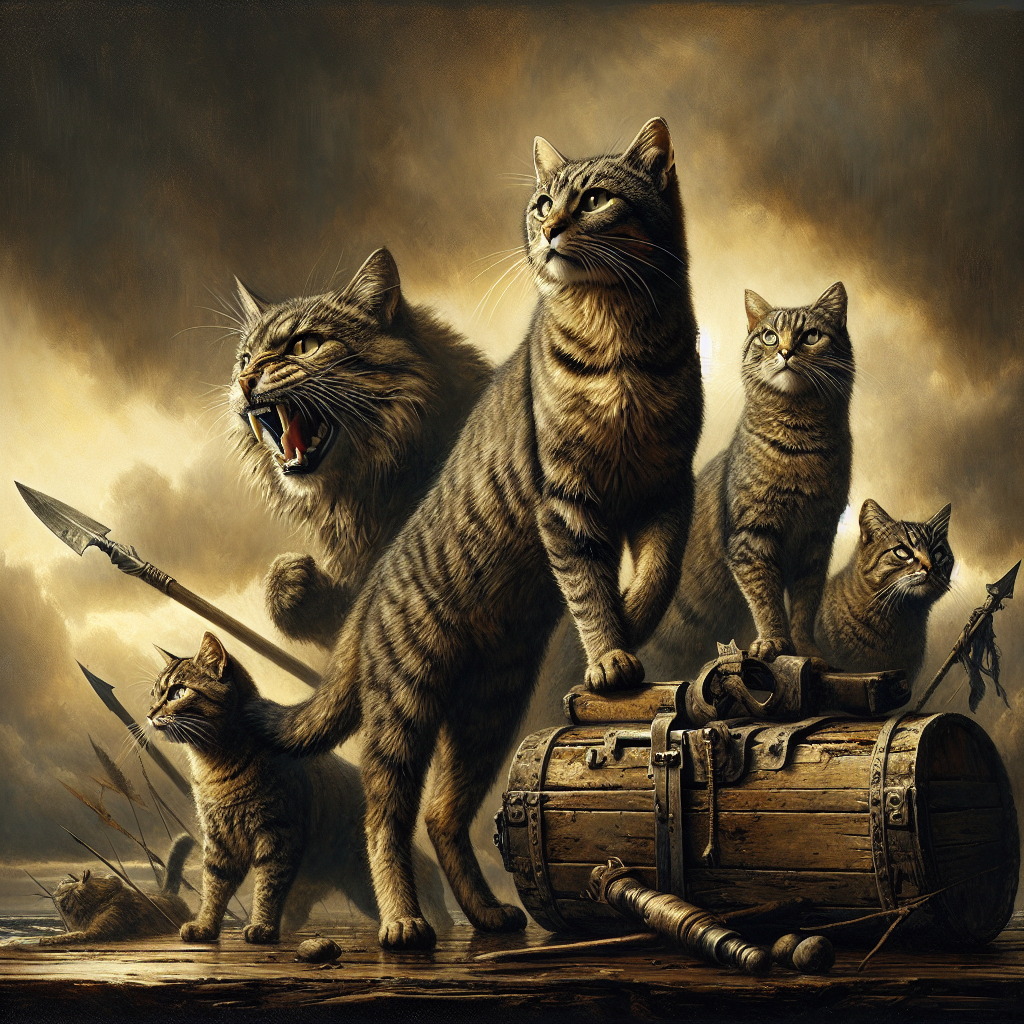Step into the world of feral tabby cats, where fearsome battles are waged and untamed warriors roam. These fierce felines possess an innate fighting prowess that sets them apart from their domestic counterparts. From snarling hisses to lightning-fast strikes, these untamed warriors are a force to be reckoned with. In this article, witness the adrenaline-pumping encounters and learn more about the gritty lives of these powerful fighters. Prepare to be captivated by the untamed world of feral tabby cats in battle.

The Untamed Warriors: Feral Tabby Cats in Battle
Feral tabby cats, with their untamed and fierce nature, have earned a reputation as formidable fighters. In this article, we will explore the origins, characteristics, hunting techniques, and social structure of these fearless felines. We will also delve into the impact of human interaction on their behavior and the controversies surrounding their battle instincts.
Feral Tabby Cats: A Brief Overview
Defining Feral Tabby Cats
Feral tabby cats are domesticated cats that have reverted to living in the wild. Tabby cats, characterized by their distinctive striped or blotchy coat patterns, come in various colors and are one of the most common breeds worldwide. When these tabby cats are abandoned or lost and left to fend for themselves, they adapt to their new environment and become feral.
Distribution and Population
Feral tabby cats can be found in various regions around the world, from urban environments to rural landscapes. Due to their ability to survive and reproduce in the wild, their population can quickly multiply, leading to challenges for local ecosystems and wildlife conservation efforts.
Survival Challenges for Feral Cats
Living as a feral cat poses numerous challenges. These cats must find food, water, and shelter on their own, often competing with other feral cats and wildlife for limited resources. They also face the dangers of predators, diseases, and harsh weather conditions. Feral tabby cats must rely on their innate instincts and hunting skills to overcome these challenges and survive in their unforgiving environments.
Feral Cat Management Programs
To address the challenges posed by feral cat populations, many organizations and communities have implemented feral cat management programs. These programs often involve trapping, neutering, and returning feral cats to their original habitats to control their numbers. Some organizations also promote adoption of feral cats as barn cats, providing them with a safer environment while still allowing them to fulfill their natural hunting instincts.
The Origins of Feral Tabby Cats
The Domestication of Cats
Cats, including tabby cats, were domesticated thousands of years ago. Initially valued for their hunting skills in controlling rodent populations, cats gradually became companions to humans. However, due to various circumstances, these domesticated cats can find themselves back in the wild, reverting to their feral instincts to survive independently.
Historical Background of Tabby Cats
Tabby cats have a long history, with evidence of their existence dating back to ancient Egypt. Believed to have descended from African wildcats, tabby cats were prized for their pest control abilities and worshipped as sacred creatures in Egyptian culture. Over time, tabby cats spread across different regions, adapting to their surroundings while retaining their distinctive tabby coat patterns.
Factors Leading to Feralization
Numerous factors can contribute to the feralization of tabby cats. Abandonment by irresponsible pet owners, being born to feral parents, or becoming lost without a means of returning home are some common paths to feralization. Once they enter the wild, these cats undergo a transformation, developing the necessary skills and behavior to survive independently.
Characteristics of Feral Tabby Cats
Physical Features
Feral tabby cats display a range of physical features typical of domestic tabby cats. Their fur patterns can vary from classic stripes to swirls and spots, providing excellent camouflage in their natural habitats. Their average size and build resemble that of domestic cats, allowing them to navigate rough terrain and pounce on prey with agility.
Behavioral Traits
Feral tabby cats exhibit a distinct set of behavioral traits that aid their survival in the wild. Their hunting instincts are particularly pronounced, as they rely on their sharp senses, agility, and stealth to catch prey. Due to their solitary nature, feral tabby cats prefer to roam and hunt alone rather than forming social bonds with other cats.
Adaptations for Survival
To adapt to their environments, feral tabby cats develop unique survival strategies. Their keen eyesight and hearing allow them to detect prey from a distance, while their retractable claws and strong hind legs enable them to climb trees and pounce on unsuspecting prey. Additionally, their flexible diet and ability to scavenge ensure they can find sustenance even in challenging circumstances.

The Battleground: Where Feral Tabby Cats Thrive
Urban Environments
Urban areas offer a rich and varied landscape for feral tabby cats. Abandoned buildings, alleyways, and dumpsters provide hideouts and possible sources of food. However, competing with other feral cats, scavenging for resources, and avoiding human interference pose constant challenges in their battle for survival.
Rural Environments
In rural environments, feral tabby cats often roam far and wide, utilizing open fields, forests, and barns as their hunting grounds and shelters. Access to small mammals and birds, coupled with greater freedom from human interference, allows them to thrive in these areas. However, encounters with predators and competition from other wild animals remain constant threats to their survival.
Impact on Local Ecosystems
The presence of feral tabby cats in both urban and rural environments can have significant impacts on local ecosystems. Their hunting activities may disrupt native wildlife populations, especially birds and small mammals. As non-native predators, they can upset the delicate balance of these ecosystems, leading to cascading effects on other species and biodiversity.
Survival of the Fittest: Natural Selection and Feral Tabby Cats
The Role of Natural Selection in Feral Cats
Predation, competition, and environmental factors shape the population of feral tabby cats through natural selection. Only the individuals with the most effective hunting skills, adaptations, and reproductive success can pass on their genes to the next generation. This process ensures that feral tabby cats evolve and develop traits that maximize their chances of survival in their specific habitats.
Adaptive Traits for Survival
Feral tabby cats possess several adaptive traits that bolster their survival in the wild. Their sharp claws and teeth allow them to capture and consume their prey efficiently. Their agility and speed enable them to take down fast-moving targets, while their excellent camouflage and nocturnal tendencies offer them an advantage in stealth hunting.
Competition with Other Species
Feral tabby cats face competition not only from other feral cats but also from native predators and other apex predators within their ecosystems. This competition for resources, territory, and mates can impact the overall population and distribution of feral tabby cats. It also highlights the importance of appropriate management strategies to mitigate potential conflicts.
The Role of Genetics in Feral Tabby Cats
Inheritance of Traits
Genetics play a crucial role in shaping the physical and behavioral traits of feral tabby cats. Inherited traits, such as coat color and pattern, eye color, and body size, contribute to their overall survival and reproductive success. The passing on of these genetic traits ensures the continuation of desired traits in subsequent generations of feral tabby cats.
Variations in Coat Colors and Patterns
One of the defining characteristics of tabby cats is their wide variety of coat colors and patterns. These variations, determined by genetic factors, can influence their ability to blend into their surroundings and evade detection by predators or prey. From the classic stripes to marble-like swirls, tabby cats exhibit a stunning array of coat patterns indicative of their genetic diversity.
Inbreeding and Genetic Health
In certain situations, feral tabby cats may face challenges associated with inbreeding. Limited gene pools and lack of genetic diversity can lead to decreased fitness and increased prevalence of certain genetic disorders. Proper management and intervention to prevent inbreeding can help maintain healthier populations of feral tabby cats and minimize genetic health issues.
Feral Tabby Cats vs. Domesticated Cats: The Battle for Territory
Territorial Behavior in Feral Tabby Cats
Territory is crucial for feral tabby cats, and they fiercely defend their designated areas. Spraying, marking, and physical confrontations with intruders are common territorial behaviors. These fights can be intense, often resulting in injuries or even death. Territory disputes among feral tabby cats are a natural consequence of their instinctual need to secure resources and ensure reproductive success.
Conflicts with Domesticated Cats
Feral tabby cats and domesticated cats may come into contact, leading to conflicts over territory and resources. Domesticated cats, accustomed to human care and protection, may be at a disadvantage when confronted with the battle-hardened skills of feral tabby cats. These clashes highlight the significant differences in behavior and survival instincts between the two populations.
Impact on Pet Cats
For pet cats that venture outdoors, encounters with feral tabby cats can present both opportunities and challenges. While some may form alliances or display companionable behaviors, conflicts within the feline hierarchy can arise. Pet owners must be aware of the potential risks and take necessary precautions to ensure the safety and well-being of their beloved pets.
Feral Tabby Cats’ Hunting Techniques
Stealth and Ambush Tactics
Feral tabby cats are masters of stealth and rely on their ability to remain undetected until the perfect moment to strike. They use their acute senses to stalk prey patiently, gradually closing the distance before launching a surprise attack. This strategy helps maximize their chances of capturing their intended target without expending unnecessary energy.
Hunting Solo or in Groups
While feral tabby cats primarily hunt alone, there are instances where they may form loose associations with other feral cats to improve their hunting success. These groups are often temporary and driven by a shared need for survival. By working together, they can increase their chances of capturing larger prey or defending against rival predators.
Prey Selection and Consumption
Feral tabby cats are opportunistic hunters, capable of adapting their diet to the available resources. Their natural inclination is to target small mammals, such as mice and rats, which pose a threat to their food sources. They are also known to hunt birds, insects, reptiles, and even small fish when the opportunity arises. Once prey is captured, feral tabby cats consume their kill either on the spot or carry it to a safe location.
The Impact of Human Interaction on Feral Tabby Cats
Human interaction can profoundly influence the behavior and survival of feral tabby cats. While some individuals may show kindness and provide food or shelter, others may view them as pests or threats to wildlife. Human interventions, such as feeding programs or trap-neuter-return initiatives, can impact the population size, health, and behavior of feral tabby cats within a given area.
Controversies Surrounding Feral Tabby Cats and Their Battle Instincts
Public Perception and Stereotypes
Feral tabby cats often suffer from negative public perception and stereotypes. Some perceive them as vicious, disease-ridden creatures, leading to misinformation and fear. These stereotypes can hinder efforts to implement humane and effective management strategies and perpetuate the cycle of challenges faced by feral tabby cats.
Conflicts with Wildlife Conservation
The presence of feral tabby cats can create conflicts with efforts to preserve vulnerable wildlife populations. Their hunting activities can impact native bird species, reptiles, and small mammals. These conflicts have sparked debates regarding the management and control of feral tabby cat populations to protect native wildlife.
Ethical Considerations in Feral Cat Management
The management of feral tabby cats raises ethical considerations. Balancing their welfare, the welfare of native wildlife, and the potential risks to human health and property is a complex task. Various approaches to feral cat management, from euthanasia to trap-neuter-return programs, have sparked controversy and discussions surrounding the most humane and effective methods.
In conclusion, feral tabby cats are untamed warriors who adapted to survive in the wild. Their origins, characteristics, hunting techniques, and social structure all contribute to their ability to thrive in challenging environments. However, their presence also presents challenges and controversies, emphasizing the need for responsible management and understanding of these captivating creatures. By appreciating their tenacity and resilience, we can work toward finding a balanced coexistence with feral tabby cats while preserving the delicate ecosystems they inhabit.

